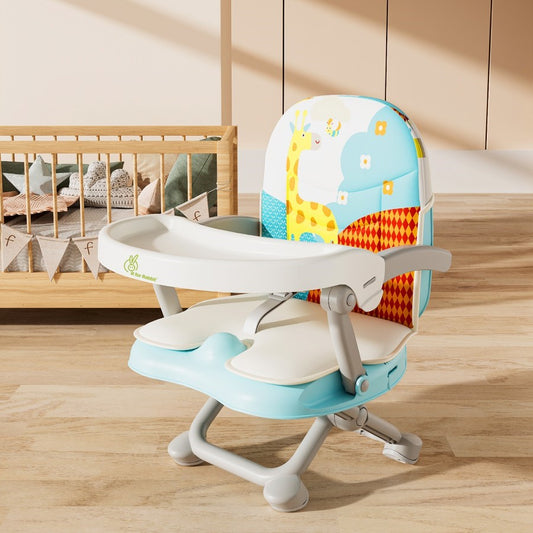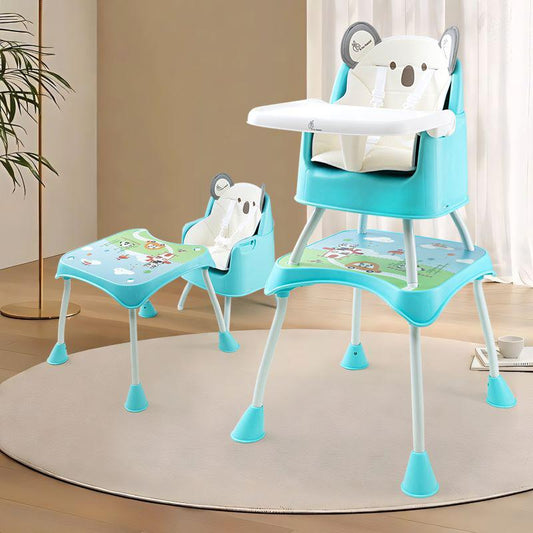Why Ergonomics Matter: The Postural Benefits of Ergonomic Chairs and Tables on Children

Does your child complain of backache or shoulder ache after sitting for long hours on a table and chair?
If yes, then this blog is a comprehensive guide to provide your child with a comfortable seating space during their activities.
According to research, children spend at least nine hours on study chairs and tables everyday, among which almost 83% of them are exposed to unsuitable ones, according to their age, height and body.
As parents, you nick-pick many tasks, activities, and essentials that your kids might require for their active growth and development. However, sometimes the necessity to make the right choice for your kids’ ergonomic furniture tends to take a back seat in the process.
In toddler years, although this span is just for 2 to 3 hours a day but still demands choosing the right ergonomic furniture for them to promote their overall development.
Children’s furniture is more than just colorful and vibrant structures, as they are specifically designed, keeping their developing bodies in mind. This is known as ergonomics, which refers to architecting the furniture on the basis of the needs and demands of the users.
A good children’s furniture focuses on promoting healthy posture, comfort, good digestion, spinal alignment, reducing strain and fatigue, and also enhancing their concentration and productivity.
Understanding Ergonomics for Children
Ergonomic is derived from two Greek words, "ergon”, meaning "work”, and "nomos”, meaning "rules". In short, ergonomics means “rules of work.”.
In simpler terms, ergonomics refers to designing the tools, furniture, or workplace according to the comfort of the users. This is done to ensure a safe, convenient, injury-free, and efficient workplace.
With children’s bodies going through different developmental phases, the importance of ergonomic furniture cannot be underestimated to support their proper spine alignment, bone development, blood circulation, concentration, and active sitting, besides also preventing the risk of musculoskeletal disorders (MSDs).
Why does starting young with ergonomic furniture matter?
We are all well aware of the fact that children spend many hours on a table and a chair in the form of a study table, meal table, activity table, etc., since their developing years.
This makes it the responsibility of the parents to promote a good posture with a good sitting habit since their childhood.
It is mandatory in order to prevent postural kyphosis, also known as hunchback, and various other bone and digestive issues in children.
Besides the benefit of ergonomic furniture for child’s posture, it is also a boon for children's:
- Cognitive development due to a comfortable seating space that aids focus and critical thinking.
- Sense of well-being due to reduction in stress, anxiety, and discomfort of any kind.
- A boost in creative learning by different experimentations and failures with peace of mind.
- Decreased fidgeting and restlessness due to a comfortable and clutter-free seating space.
- Self-awareness of their bodies due to fostering independence by customizing their seating space.
- Efficient breathing, routine, discipline, adaptable learning, and spatial awareness skills.
The Role of Chairs in Child Posture
A good postural alignment on a chair is essential to prevent various other issues like eye strain, headache, back ache, shoulder ache, fatigue, etc., while also promoting their overall health and well-being.
The proper alignment of the body while being seated on the chair should be 90-90-90-90, that is:
- The feet should be at 90 degrees with the ground.
- The knees should be bent at 90 degrees.
- The armrests should also be at 90 degrees with the shoulders.
- The angle between the trunk and the things should also be 90 degrees.
Why kids need ergonomic chairs
Due to the children's fast-paced physical growth during their initial years, the ergonomic chairs become like a nitrogen booster to their active postural development.
The ergonomic chair benefits can be guaranteed if it contains features like:
- Adjustable seat height: This feature compels the right formation of the spine and bones as it can be adjusted with respect to the height of the child. It also supports a healthy lumbar region, that is, the lower back, which is actively engaged while sitting. It is also essential for optimal thigh development and enhanced blood circulation in the legs to prevent numbness and also promotes a comfortable seating space.
- Spine/back support: A good chair would always facilitate the prevention of any kind of back strain and discomfort due to long sitting hours. A good back support also promotes a healthy spinal development that encourages natural inward spine curve, thus eliminating the risk of slouching, along with 90-degree hip flexion and reduction of muscle fatigue.
- Armrests: This makes seating comfortable due to less strain on shoulders and arms and also promotes good blood circulation in the hands.
- Dynamic seating: This is one of the essential features that supports active sitting, like rocking or tilting while remaining seated. It also engages the core muscles for their healthy development.

Such multifunctional chairs are a transition from a traditional chair to a modern one, encouraging active adaptation to children’s natural curvature of the body.
Such postural benefits of ergonomic chairs end up benefiting the children in the long run.
The Significance of Tables in Ergonomics
In order to use a table with a chair for an activity, it should be ensured that it fits like a nut in the bolt. That is, their designs must always be in sync with each other to facilitate a good working environment.
An ergonomic table/desk and chair for a child's healthy posture development includes:
- Matching table height: This ensures the child’s arms are placed at 90-degree flexion on the table, thus encouraging them to pursue a focused learning environment. A matching height of table and chair also promotes a sense of safety, fosters independence, and also promotes active engagement with the tasks at hand.
- Surface area: A table with a good surface area promotes a freedom to customize in children, thus personalizing their workspace. A customized organization of materials by reduction of clutter and space for proper bifurcation of different collaborative materials with calendars, puzzles, timers, posters, reading, writing, drawings, etc., also enhances their learning will and engagement opportunities.
Besides this, the postural benefits of ergonomic furniture also include enhanced mobility and foot rest, adjustability to accommodate various body shapes and sizes, visual ergonomics to promote a stress-free vision, etc.
Long-term benefits of ergonomic furniture
The selection of kids’ ergonomic furniture during their initial years has more to it than just a good postural alignment. It also fosters good seating habits, discipline, independence, ownership over the learning environment, focus, and positive time management right from their childhood.
Some important long-term benefits of kids’ ergonomic furniture also include:
- Prevention of musculoskeletal issues: This includes a range of underlying health conditions like chronic pain due to poor posture, reducing wear and tear by promoting natural joint positioning, enhanced flexibility and awareness, and lowering the risk of injury by minimizing a strenuous work session on the furniture. This also encourages mindfulness about healthier lifestyle choices.
- Enhancing concentration and learning: A comfortable and supportive work environment enhances cognitive functioning, problem-solving, critical thinking, and creative skills, reduces distractions and fatigue with productive working space, and also encourages a peaceful and positive space for focused productive sessions. This also leads to the culmination of future healthier habits in the long run.
Also Read: Baby High Chair Safety Guide & Usage Tips
Tips for Setting Up an Ergonomic Study Area at Home
A dedicated study area at home not only provides a productive studying habit but also aids proper postural, digestive, and essential cognitive and spatial awareness skills in children.
This supportive learning space also enhances their memory retention, fosters creativity, and develops lifetime habits that are beneficial to leading a healthy life.
A good ergonomic study area at home should include:
- Selection of right furniture: The most essential things to keep in mind are:
- Adjustable table to support the growing height of the children and the one that is comfortable for both sitting and standing preferences.
- A supportive chair with good lumbar support to prevent hunchback and various other musculoskeletal issues.
- A spacious desk to ensure enough space to support modern digital education with study materials, laptop/ desktop, mouse, and keyboard. Choose ergonomic keyboards and mouse to facilitate a natural wrist movement.
- A good footrest to ensure proper leg alignment with the floor to prevent numbness and enhance blood circulation, thus preventing lethargy and distractions.
- Arrangement and Environment: After the selection of the furniture, its proper placement at home also influences the learning workspace. Some important points include:
- Ensure to place kids’ ergonomic furniture in a well-lit and well-ventilated room to reduce eye strain and promote good breathing, thus fostering a motivation to study. Placing a study lamp at the corner could also enhance the study sessions.
- Ensure the screen height should be at eye level to prevent any neck, eye, or shoulder strain.
- Incorporate a flexible study space to move the furniture around effortlessly when needed.
- A vertical storage space is always a plus, as it allows easy bifurcation of the study materials and stationary off the desk, thus promoting a clean study space.
- Ensure to create a study space away from any sort of noise, vision, and sensory distractions, thus encouraging productivity during study time.
Also Read: How to Choose the Best Study Table for Your Child?
Conclusion
The requirement of good ergonomic furniture for kids must be well understood till now. Besides being shape sorters for children's growing bodies, they also encourage an overall smooth functioning of their internal body.
The postural benefits of an ergonomic chair and table can be measured in terms of effects of increased sedentary lifestyle in current times. This includes long hours of studying or working by remaining seated at one place leading to health issues like chronic back pain, neck strain, carpal tunnel syndrome, sciatica etc.
Therefore, as parents, it is really important to make a wise choice in the selection of your kids’ ergonomic furniture, promoting not only healthy development in childhood but also healthy habits for the future.
Also, if you are seeking to purchase kids’ ergonomic furniture to support their growth and development, then explore the R for Rabbit’s kids’ furniture to give your child one of the best personalized work spaces with optimum comfort, safety, and reliability.














